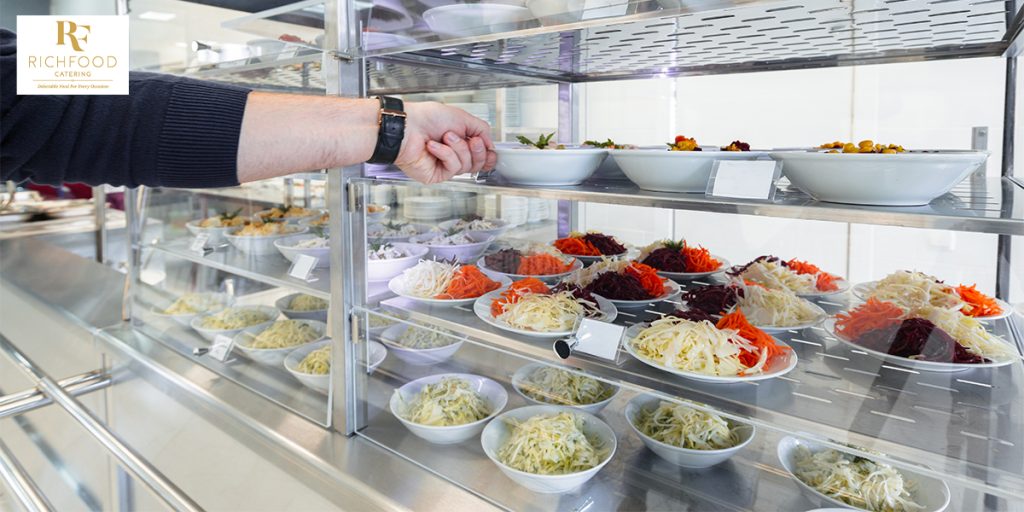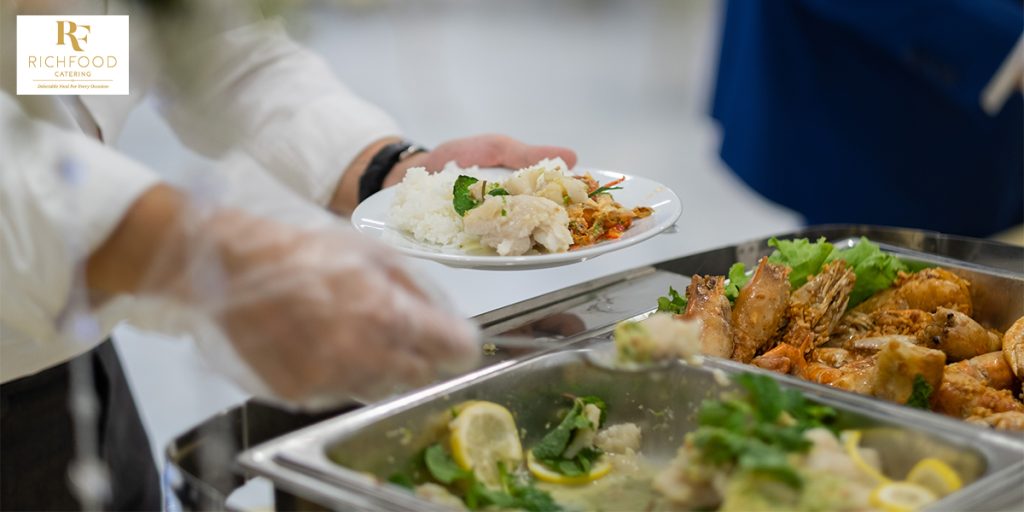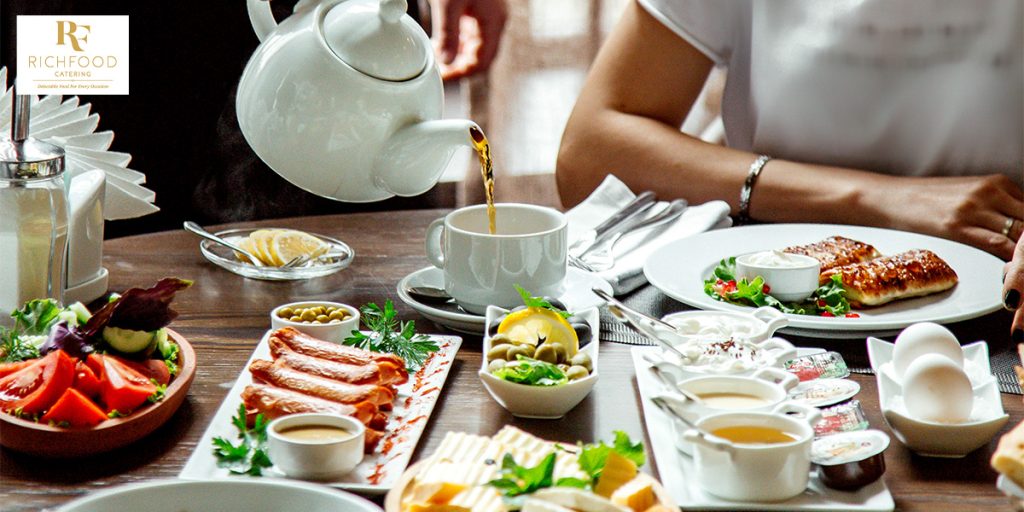
- RichFood Marketing
- September 22, 2023
- 12:09 pm
History of Buffet Catering: From Ancient Times to Modern Trends
Introduction
Hello there, food enthusiasts! If you’re anything like me, you’ve probably savored the delights of a buffet spread at one point in your life. Buffet catering is a culinary journey filled with history and modern innovation, and today, I’m excited to take you on a flavorful trip from the ancient times to the latest trends. Whether you’re planning a wedding, corporate event, or just love a good feast, understanding the history of buffet catering can help you appreciate this dining style even more.
Ancient Origins and History of Buffet Catering and Dining
Let’s start with the basics. The concept of buffet-style dining has deep roots in ancient civilisations. Imagine this, a grand Egyptian feast where guests helped themselves to a variety of dishes displayed on large tables. It was a communal experience where people came together to celebrate.
Renaissance and Royal Banquets
Fast forward to the Renaissance era in Europe. Buffet catering wasn’t just about food; it was an art form! Picture opulent banquets with elaborately decorated tables laden with delicacies. These royal buffets were a symbol of status and extravagance.
Renaissance buffets were:
- Lavish, with a wide variety of food
- Served on fine china and crystal
- A place for socializing and networking
- A way for the wealthy and powerful to show off their wealth and status
- A way for people to come together and enjoy a meal in a beautiful setting
This fact alone makes the Renaissance era noteworthy in the history of buffet catering.
The American Influence
Now, let’s hop across the Atlantic to the United States for more history of buffet catering. American-style buffets took the world by storm. All-you-can-eat buffets became iconic, offering a wide range of cuisines and flavors under one roof. They were a hit with people of all ages and backgrounds, and they quickly became a popular dining option.
Buffets catering offered a great value for money, and they were a convenient way to try a variety of different foods. They were also a great place to socialize and meet new people. Buffets have since become a staple of the dining scene in many countries around the world. They are a popular choice for both casual and formal dining, and they offer a great way to enjoy a variety of different foods.
Buffet Catering in Post-Independence Singapore
In Singapore, the history of buffet catering really started to take off after independence in 1965. The country’s diverse population, which includes Malays, Chinese, Indians, and Peranakans, has led to a wide variety of buffet offerings. There is something to satisfy every palate, from traditional Malay dishes like nasi lemak to Chinese dim sum to Indian curries.
Buffets are a popular way to celebrate special occasions or simply enjoy a meal with friends and family. They are also a great way to sample different cuisines without having to commit to a full meal at a single restaurant.
RichFood Stories: I recall the early days when my catering business started. We had a tiny kitchen and a big dream. We experimented with fusion dishes that combined flavours from different cultures, and it clicked! This marked the beginning of a new era for us.
Modern Buffet Catering Trends
Fast forward to today, and buffet catering has evolved in fascinating ways. Modern buffets have moved beyond traditional boundaries. It’s not just about stuffing yourself; it’s about savoring a culinary journey.
Fusion of Global Cuisines
Buffets now showcase a fusion of global cuisines, offering a wide variety of dishes from different cultures. Imagine a buffet spread that offers sushi alongside pasta, dim sum next to tacos – the possibilities are endless! This type of buffet allows diners to try a variety of different foods without having to commit to a single dish or cuisine. It can also be a great way to introduce people to new foods that they may not have otherwise tried.
Buffets that offer a fusion of global cuisines can be found in many different countries around the world. They are often popular tourist destinations, as they offer a unique and delicious dining experience.
Dietary Preferences and Health-Conscious Options
In today’s health-conscious world, buffet caterers are accommodating dietary preferences and providing healthier choices. You’ll find gluten-free, vegan, and low-carb options alongside the classics. This is a great trend, as it allows people to enjoy a variety of foods without having to worry about their dietary restrictions. It is also a good way to promote healthy eating habits, as people are more likely to choose healthy options when they are available.
In addition to gluten-free, vegan, and low-carb options, buffet caterers are also offering more plant-based and sustainable options. This is a positive development, as it helps to reduce the environmental impact of food production. It also allows people to enjoy delicious and nutritious food without harming the planet.
Technological Advancements in Buffet Catering
The digital age has had a profound impact on many aspects of our lives, thus changing the history of buffet catering to be more advanced and sophisticated. Technology has made it possible to offer a more convenient and interactive dining experience for customers. For example, some buffets now offer online ordering and payment options, which can save customers time and hassle. Additionally, many buffets now use interactive menus that allow customers to view and order food items from their table. This can help to reduce wait times and improve the overall dining experience.
Here are some other ways that technology has changed buffet catering:
- Online ordering and payment: Customers can now order and pay for food online, which can save time and hassle.
- Interactive menus: Customers can view and order food items from their table, which can reduce wait times.
- Mobile apps: Mobile apps allow customers to order food, pay for their meals, and even track their calorie intake.
- Self-service kiosks: Self-service kiosks allow customers to order and pay for food without having to wait in line.
- Table service: Some buffets now offer table service, which can be more convenient for customers who want a more leisurely dining experience.
Overall, technology has made it possible to offer a more convenient and interactive dining experience for customers. This has helped to make buffet catering a more popular option for both individuals and businesses.
Mobile Apps and Online Ordering
Many catering services now offer mobile apps for seamless ordering and customisation. This means that you can plan your entire buffet from the comfort of your smartphone. You can browse through the menu, select the items you want, and customise them to your liking.
You can also add or remove items, change the quantity, and choose the delivery date and time. Once you are satisfied with your order, you can simply pay for it and your food will be delivered to your door. This is a convenient and easy way to order catering for your next event.
Digital Displays and Presentation
Digital screens are replacing traditional signage in restaurants. They offer several advantages: dynamic menus, visual appeal, and additional information. Overall, they improve the dining experience for both customers and restaurants.
Sustainability and Eco-Friendly Practices
In today’s eco-conscious world, buffet caterers are taking steps to minimize their environmental footprint. Here are some of the ways they are doing this:
- Using sustainable and biodegradable materials for their food packaging.
- Reducing food waste by only preparing the amount of food that is needed.
- Composting food scraps and other organic waste.
- Using energy-efficient appliances and equipment.
- Recycling and reusing materials whenever possible.
- Educating their customers about the importance of sustainability.
These are just a few of the ways that buffet caterers are helping to protect the environment. By making small changes, they can make a big difference.
RichFood Catering Eco-Friendly Effort: We’ve made a commitment to sustainability in our catering business. We now use eco-friendly packaging, source locally, and have reduced food wastage significantly. It’s not just about serving great food; it’s about doing it responsibly.

The Future of Buffet Catering
The future of buffet catering is a world of exciting possibilities. With the advent of new technologies and trends, buffet catering is becoming more and more innovative. Here are a few trends that we can expect to see in the future of buffet catering:
- Personalization: Buffets are becoming more personalized, with options for guests to customize their own meals. This can be done through interactive menus, self-service stations, and even 3D printing.
- Sustainability: Buffet caterers are becoming more sustainable, using locally-sourced ingredients and reducing food waste. This can be done through composting, recycling, and upcycling.
- Health and wellness: Buffets are becoming healthier, with more options for plant-based and gluten-free dishes. This can be done by working with chefs to create healthy and delicious dishes.
- Technology: Technology is changing the way buffets are operated. For example, mobile apps can be used to order food and track inventory. This can make buffets more efficient and convenient for both guests and caterers.
These are just a few of the trends that we can expect to see in the future of buffet catering. With the continued innovation in the industry, buffets are sure to remain a popular choice for events of all sizes.
More Innovation
Virtual reality dining experiences are a new and exciting way to enjoy food. With VR, you can travel to different countries and try different cuisines without ever leaving your seat. You can also experience new and unique dining experiences that would be impossible in the real world. For example, you could dine with dinosaurs or have a picnic on the moon. VR dining experiences are still in their early stages, but they have the potential to revolutionize the way we eat.
Here are some other potential innovations in buffet offerings:
- Personalized menus: AI-powered menus that can recommend dishes based on your preferences.
- Self-ordering kiosks: Kiosks where you can order and pay for your food without having to wait in line.
- Robotic chefs: Robots that can cook and serve food.
- Drone delivery: Drones that can deliver food to your table.
- In-table cooking stations: Tables that have built-in cooking stations so you can cook your own food.
- Smart utensils: Utensils that can track your calorie intake and nutritional information.
- Virtual reality dining experiences: VR experiences that allow you to dine in different locations or with different people.
Challenges and Opportunities
As buffets go high-tech, there will be challenges to maintaining quality. For example, it will be important to ensure that the food is fresh and that the buffet is properly cleaned. However, these challenges also present opportunities for growth and creativity. For example, buffets could use technology to offer a wider variety of food options or to provide personalized recommendations to customers.
Enduring Appeal
Despite all the changes, the timeless appeal of buffet catering remains. It is about sharing good food, good company, and creating memorable experiences. Buffets are a great way to feed a large group of people without having to worry about everyone getting their food at the same time. They are also a great way to try new foods and to sample a variety of dishes. Buffets can be casual or formal, and they can be used for a variety of occasions, such as weddings, birthdays, and corporate events.
Buffets are a great way to create a sense of community and camaraderie. When people gather around a buffet table, they are able to interact with each other and share stories. This can lead to the creation of lasting friendships and memories.
Conclusion
The history of buffet catering is a rich tapestry that has woven its way through cultures and centuries. From the ancient feasts of Egypt to the modern fusion buffets in Singapore, this culinary journey has been a testament to human creativity and culinary artistry.
As a catering provider in Singapore, I’ve witnessed this evolution firsthand, and it’s been an incredible ride. I encourage you to explore the world of buffet catering, embrace the modern trends, and savor the delicious history that has brought us to where we are today.
So, whether you’re planning your next event or simply looking for a delightful dining experience, remember that buffet catering is more than just food on a table; it’s a journey through time and taste. Bon appétit!
Catering FAQ
1. What is the history of buffet catering?
A: The concept of buffet-style dining has deep roots in ancient civilizations, such as Egypt and the Roman Empire. During the Renaissance era, buffet catering became a popular way for the wealthy and powerful to show off their wealth and status. In the United States, buffet catering became popular in the early 1900s, and it has since become a staple of the dining scene in many countries around the world.
2. What are some of the trends in buffet catering today?
- Fusion of global cuisines: Buffets now showcase a fusion of global cuisines, offering a wide variety of dishes from different cultures.
- Dietary preferences and health-conscious options: Buffet caterers are accommodating dietary preferences and providing healthier choices, such as gluten-free, vegan, and low-carb options.
- Technological advancements: Technology has made it possible to offer a more convenient and interactive dining experience for customers. For example, some buffets now offer online ordering and payment options, as well as interactive menus that allow customers to view and order food items from their table.
- Mobile apps and online ordering: Many catering services now offer mobile apps for seamless ordering and customization. This means that you can plan your entire buffet from the comfort of your smartphone.
- Digital displays and presentation: Digital screens are replacing traditional signage in restaurants. They offer several advantages: dynamic menus, visual appeal, and additional information. Overall, they improve the dining experience for both customers and restaurants.
- Sustainability and eco-friendly practices: Buffet caterers are taking steps to minimize their environmental footprint by using sustainable and biodegradable materials, reducing food waste, and composting food scraps.
3. What does the future of buffet catering hold?
A: The future of buffet catering is a world of exciting possibilities. With the advent of new technologies and trends, buffet catering is becoming more and more innovative. Here are a few trends that we can expect to see in the future of buffet catering:
- Personalisation: Buffets are becoming more personalized, with options for guests to customize their own meals. This can be done through interactive menus, self-service stations, and even 3D printing.
- Sustainability: Buffet caterers are becoming more sustainable, using locally-sourced ingredients and reducing food waste. This can be done through composting, recycling, and upcycling.
- Health and wellness: Buffets are becoming healthier, with more options for plant-based and gluten-free dishes. This can be done by working with chefs to create healthy and delicious dishes.
- Technology: Technology is changing the way buffets are operated. For example, mobile apps can be used to order food and track inventory. This can make buffets more efficient and convenient for both guests and caterers.
4. What are some tips for choosing a buffet caterer?
A: When choosing a buffet caterer, there are a few things you should keep in mind:
- Reputation: Ask around for recommendations and read reviews of different catering companies.
- Experience: Choose a caterer with experience in catering buffets.
- Menu: Make sure the caterer offers a menu that includes a variety of dishes that you and your guests will enjoy.
- Pricing: Get quotes from several different caterers before making a decision.
- Contract: Be sure to sign a contract with the caterer that outlines all of the details of your event, including the menu, pricing, and cancellation policy.
